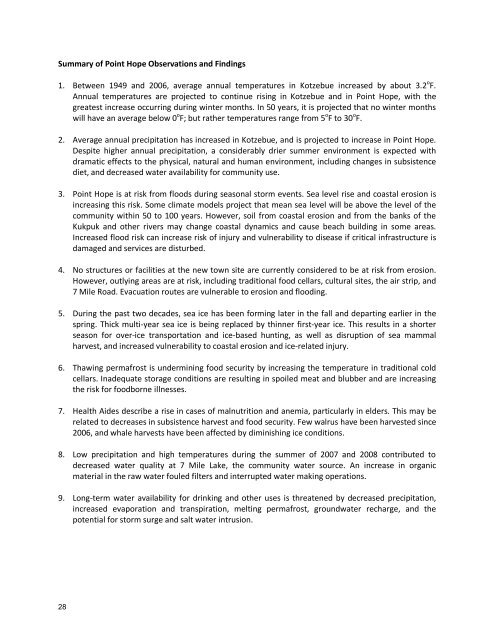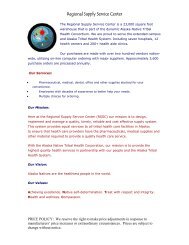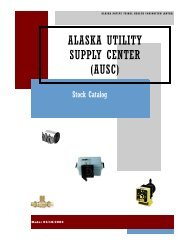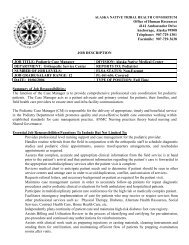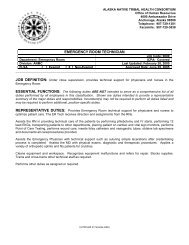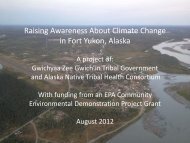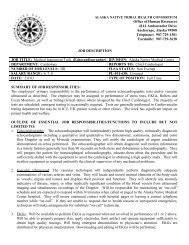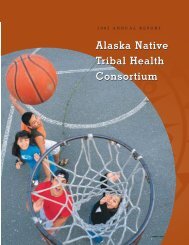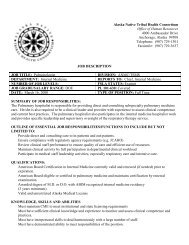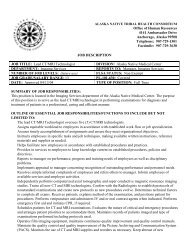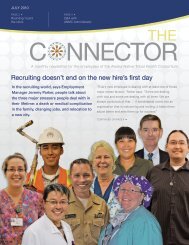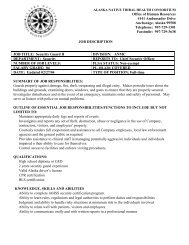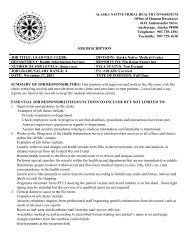Draft Final Climate Change and Health Impacts Point ... - ANTHC
Draft Final Climate Change and Health Impacts Point ... - ANTHC
Draft Final Climate Change and Health Impacts Point ... - ANTHC
You also want an ePaper? Increase the reach of your titles
YUMPU automatically turns print PDFs into web optimized ePapers that Google loves.
Summary of <strong>Point</strong> Hope Observations <strong>and</strong> Findings<br />
1. Between 1949 <strong>and</strong> 2006, average annual temperatures in Kotzebue increased by about 3.2 o F.<br />
Annual temperatures are projected to continue rising in Kotzebue <strong>and</strong> in <strong>Point</strong> Hope, with the<br />
greatest increase occurring during winter months. In 50 years, it is projected that no winter months<br />
will have an average below 0 o F; but rather temperatures range from 5 o F to 30 o F.<br />
2. Average annual precipitation has increased in Kotzebue, <strong>and</strong> is projected to increase in <strong>Point</strong> Hope.<br />
Despite higher annual precipitation, a considerably drier summer environment is expected with<br />
dramatic effects to the physical, natural <strong>and</strong> human environment, including changes in subsistence<br />
diet, <strong>and</strong> decreased water availability for community use.<br />
3. <strong>Point</strong> Hope is at risk from floods during seasonal storm events. Sea level rise <strong>and</strong> coastal erosion is<br />
increasing this risk. Some climate models project that mean sea level will be above the level of the<br />
community within 50 to 100 years. However, soil from coastal erosion <strong>and</strong> from the banks of the<br />
Kukpuk <strong>and</strong> other rivers may change coastal dynamics <strong>and</strong> cause beach building in some areas.<br />
Increased flood risk can increase risk of injury <strong>and</strong> vulnerability to disease if critical infrastructure is<br />
damaged <strong>and</strong> services are disturbed.<br />
4. No structures or facilities at the new town site are currently considered to be at risk from erosion.<br />
However, outlying areas are at risk, including traditional food cellars, cultural sites, the air strip, <strong>and</strong><br />
7 Mile Road. Evacuation routes are vulnerable to erosion <strong>and</strong> flooding.<br />
5. During the past two decades, sea ice has been forming later in the fall <strong>and</strong> departing earlier in the<br />
spring. Thick multi‐year sea ice is being replaced by thinner first‐year ice. This results in a shorter<br />
season for over‐ice transportation <strong>and</strong> ice‐based hunting, as well as disruption of sea mammal<br />
harvest, <strong>and</strong> increased vulnerability to coastal erosion <strong>and</strong> ice‐related injury.<br />
6. Thawing permafrost is undermining food security by increasing the temperature in traditional cold<br />
cellars. Inadequate storage conditions are resulting in spoiled meat <strong>and</strong> blubber <strong>and</strong> are increasing<br />
the risk for foodborne illnesses.<br />
7. <strong>Health</strong> Aides describe a rise in cases of malnutrition <strong>and</strong> anemia, particularly in elders. This may be<br />
related to decreases in subsistence harvest <strong>and</strong> food security. Few walrus have been harvested since<br />
2006, <strong>and</strong> whale harvests have been affected by diminishing ice conditions.<br />
8. Low precipitation <strong>and</strong> high temperatures during the summer of 2007 <strong>and</strong> 2008 contributed to<br />
decreased water quality at 7 Mile Lake, the community water source. An increase in organic<br />
material in the raw water fouled filters <strong>and</strong> interrupted water making operations.<br />
9. Long‐term water availability for drinking <strong>and</strong> other uses is threatened by decreased precipitation,<br />
increased evaporation <strong>and</strong> transpiration, melting permafrost, groundwater recharge, <strong>and</strong> the<br />
potential for storm surge <strong>and</strong> salt water intrusion.<br />
28


